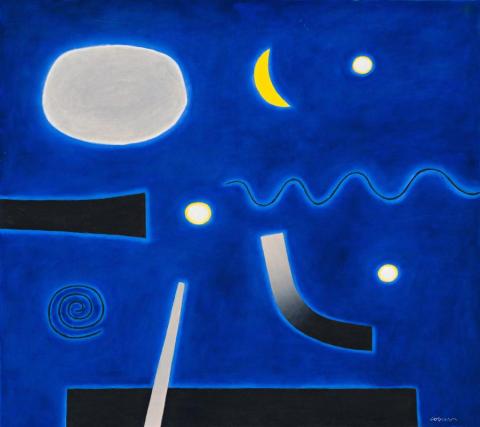MIDNIGHT, 2003
John Coburn
oil on canvas
100.0 x 112.0 cm
signed lower right: Coburn
inscribed verso: MIDNIGHT 2003
Greythorn Galleries, Melbourne
Private collection, Melbourne
An engaging sense of joy and celebration runs throughout John Coburn's art derived from the resonance of his colours and pulsating forms. Its appeal is extended through that paradox of profundity couched in terms of disarming simplicity - of pure, unbroken colours and forms geometric and biomorphic. As one of Australia's finest religious painters, there are works that express anguish, pain and lament, for how otherwise could one convey the horrors of crucifixion? Others capture the starkness of drought or the red-hot harshness of the desert. But joy and celebration triumph through the employment of brilliant colours and festive forms. This is seen in such titles as 'hozanna', 'fanfare' and 'festive image', as Coburn reveals himself as the Australian master of the sound of colour. From obvious correlations in Drum Beat 1972 in the collection of the Art Gallery of Western Australia, and Fanfare 1974, to Singing the Blues 1987, he embraced the sun as the source of life and energy and painted in praise Canticle of the Sun 1965. Plant forms and tongues of flame spread across the three bands of the composition like notes in a musical score. Continued in his masterly tapestry curtains for the Sydney Opera House, Curtain of the Sun expresses the sounds and colours of day, and Curtain of the Moon those of night. Such vital, regenerative forces are also seen in his series of tapestries of the Creation 1969 (John F. Kennedy Centre for the Performing Arts, Washington), and The Seasons 1987. The forces of nature and the spiritual world were a constant inspiration his, the tropical fruitfulness of north Queensland spilling over into Primordial Garden 1965-66 in the collection of the National Gallery of Victoria, Melbourne. The 1966 painting, Dark Descent in the collection of the Newcastle Region Art Gallery, expresses awe at the vastness of the universe as experienced so dramatically in the setting of the sun. The combination of the natural with the spiritual finds celebratory fulfilment in the Tree of Life III painting of 1973 in the collection of Vatican Museum, Rome.
Midnight 2003 emerged from this rich background, exploring a particular time of change as a one of celebration of the new, the new day, the new year, and the new millennium. Heavy primal and biomorphic forms give way to lighter, Miro-like imagery, sporting across a vibrant field of blue. The thin wavy line provides a linear element, now elegant and light-hearted. Images on the picture plane seem to float in an infinite depth of blue, the whole painting evoking that serenity that great painters achieve in their final years of peaceful resolution.
